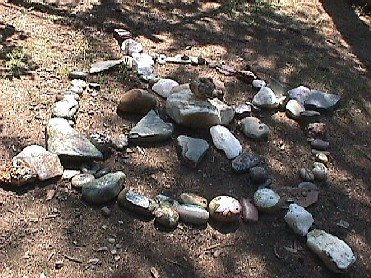

1. Lamps of the Arctic/Subarctic culture area were
2. Which of the following statements about the Eastern Woodlands
mortuary complex is false?
a. burial rites were often performed in kivas, which were special mortuary structures that were burned after use.
b. projectile points, ceramic vessels, worked animal bone, and personal ornaments were often placed with the body.
c. some bodies were buried in earthen mounds.
d. burial chambers included log-lined tombs, stone box graves, and charnel houses.
e. cremations and bundle burials were practiced.
3. One of the oldest cliff drive bison kill sites in the Great
Plains is
a. Plainview, Texas.
b. Olsen-Chubbock, Colorado.
c. Medicine Wheel, Montana.
d. Cahokia, Illinois.
e. Danger Cave, Utah.
4. Sacred village bundles of the Great Plains contained all of the
following items except
a. maize.
b. ochre and other pigments.
c. calumets.
d.
copper cut-outs.
e. bison parts.
5. What type of artifact is pictured below? What culture area is
it associated with?

a. mica cut out, American Southwest
b. copper cut out, Eastern Woodlands
c. smoking pipe, Eastern Woodlands
d. mica cut out, Eastern Woodlands
e. basket decoration, American Southwest
6. True or False: The
primary
environmental challenge facing prehistoric people in the American
Southwest
was the dry, arid climate.
7. True or False:
Basketry
was noted as a diagnostic feature of two culture areas, the Great
Plains
and the Far West. American
Southwest,
not Great Plains
8. True or False: Plant
processing
tools used in the Far West include milling stones, bedrock mortars, and
mortars-pestles.
9. True or False: The
Arctic/Subarctic
culture area is characterized by lamps, kayaks, umiaks, and bead
work.
Not bead work
10. The artifact pictured below would most likely be found in
the Great Plains
culture area.

11. Maize, beans, and squash were cultivated in both the
Eastern Woodlands and the American Southwest. However, sunflower
or ragweed was a crop unique to the Eastern
Woodlands
and cotton was a crop
unique to the American Southwest.
12. Turquoise is a diagnostic feature of the American
Southwest culture area.
13. The Plateau, Northwest Coast, Great Basin and California
comprise
the Far West
culture
area.
14. A prehistoric cultural groups associated with the
Arctic
/ Subarctic is Dorset, Thule or Eskimo
.